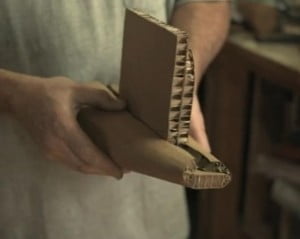 hey are made of recycled cardboard, can withstand water and humidity, cost nearly nothing – and might change the concept of green vehicle. Izhar Gafni is a Kibbutz resident, who decided to prove to his fellow engineers that he could make a bicycle at nearly no cost.
hey are made of recycled cardboard, can withstand water and humidity, cost nearly nothing – and might change the concept of green vehicle. Izhar Gafni is a Kibbutz resident, who decided to prove to his fellow engineers that he could make a bicycle at nearly no cost.
“They said it was impossible”
Gafni’s bicycle redefines the idea of green transportation in every way, being environmentally friendly from early stages of production all the way through creation of the final product. The bicycles are made out of recycled and used cardboard.
The primary use, like any bicycle, is to prevent pollution while encouraging physical activity and exercise. In an interview with Newsgeek, Gafni said that the production cost for his recycled bicycles is around $9-12 each, and he estimates it could be sold to a consumer for $60 to 90, depending on what parts they choose to add.
“I really love bicycles, and when I worked in the United States I inquired in California to see if anyone has already thought of the concept of a cardboard bicycle. To my delight, I only discovered similar concepts based on bamboo. But when I started asking engineers about the possibility of producing a cardboard bicycle, I was sent away and told that the realization of my idea is impossible. One day I was watching a documentary about the production of the first jumbo jet – and an engineer on the team had said that when everyone tells him that what he is doing is impossible – it makes it even clearer to him that he is progressing in the right direction. That saying motivated me to experiment with different materials on cardboard, to find what produces the desired strength and durability.”
Gafni, who decided to take this on as a personal project, conducted several experiments to see how he could make the recycled cardboard strong enough to carry a person weighing up to 140 kilograms. Finally, he created several prototypes that were fairly durable but too bulky.
“My first prototypes looked like delivery boxes on wheels. They were hefty and it didn’t take much imagination to see that they were made of cardboard. When I met with investors it was difficult to explain my ultimate vision with the bikes, which led me to understand that I need to devote more time towards developing a more comfortable design, lighter and more impressive.”
Judging based on the prototypes leaning on the wall during the interview with Gafni, it seems that his hard work paid off. The prototype in the room was impressive. It was hard to believe there was any relationship between that bicycle and cardboard. The bicycle is coated with a strong solid layer of brown and white material, making the finished product look like it is made of hard lightweight plastic.
There’s nothing to steal
In Tel Aviv, for example, where all but a few cyclists have had their bikes stolen at some point, low-cost bikes are all the more attractive and also weaken the sting of a steal. If the bicycle costs less than the lock required to keep it safe, the appeal and potential profit from stealing a bicycle are significantly reduced.
Additionally, those who decide to add a removable engine to make the bicycle electric can take the engine with them after parking it. The engine is the most expensive component and the bicycle itself is no longer worth the thief’s trouble. Thus, Gafni’s low-cost bicycle can be an especially attractive city vehicle.
You can read the original article there

